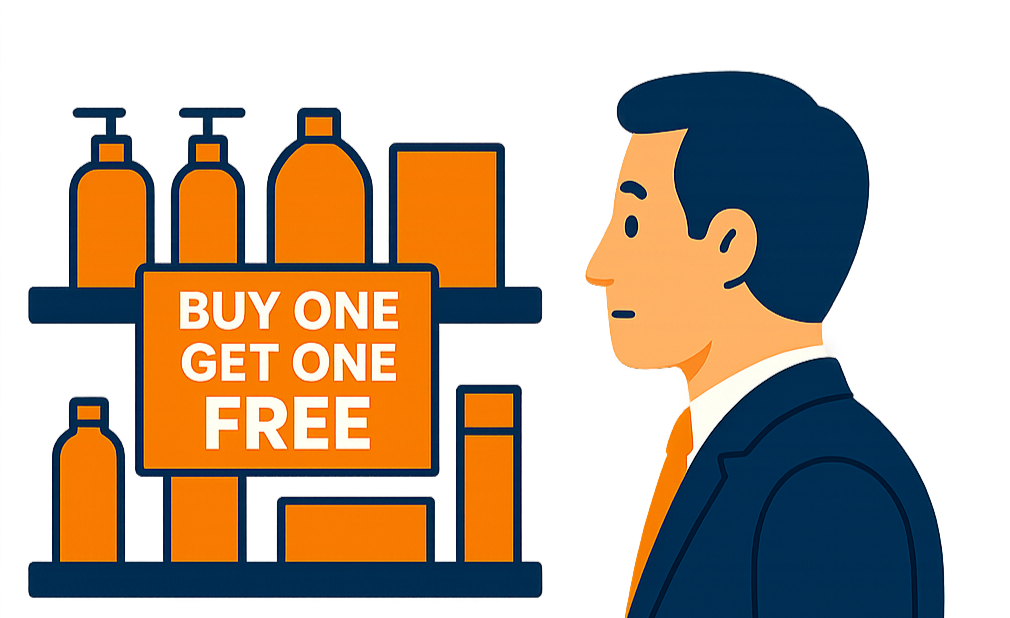In UK retail, a powerful shift is underway that is quietly transforming how brands grow, compete, and survive. It is called the barbell effect, and it is changing the shape of the entire market. Originally used in finance and business strategy, the barbell effect describes a market that becomes polarised between two extremes. Imagine a weightlifter’s barbell, with heavy weights at each end and a narrow, fragile bar in the middle. This is now the story of UK retail, where success is increasingly found at the edges rather than the centre.
What the Barbell Effect Means for Retail
When applied to retail, the barbell effect describes how growth and profitability are concentrating at both ends of the market. On one side, premium brands are thriving through quality, experience, and authenticity. On the other, value leaders are dominating through price, efficiency, and scale. The middle ground, once home to established high-street names, is shrinking fast. Consumers are making clearer choices than ever before. They either want the very best price or the very best experience. Retailers that try to stay in the middle, offering moderate value at moderate prices, are being squeezed from both sides. They are not cheap enough to attract price-driven shoppers and not distinctive enough to win loyalty from customers seeking quality and meaning.
The Two Ends of the Barbell Effect in Retail
At one end of the barbell effect are the value leaders. These retailers focus relentlessly on scale, low operational costs, and unbeatable prices. Their proposition is simple: maximum convenience at the lowest possible cost. Customers at this end are highly price-sensitive and transactional. Aldi, Lidl, B&M, Home Bargains, and Amazon Marketplace are clear examples of how this strategy works. They deliver value, speed, and simplicity on an immense scale. At the other end of the barbell effect are the experience and quality leaders. These are brands that win by delivering something special. Their strength lies in storytelling, craftsmanship, and emotional connection. Customers are willing to pay more because they see and feel the value. Selfridges, Harrods, and many direct-to-consumer artisanal brands thrive here by offering products and experiences that feel personal, ethical, and aspirational.
The Squeezed Middle in the Barbell Effect
The centre of the barbell is where the struggle lies. Retailers in this position are trapped between two extremes. They are not large enough to compete on price and not distinctive enough to compete on experience. Many long-established department stores and mid-market fashion brands are facing this exact challenge. They cannot outprice fast-fashion brands, nor can they deliver the storytelling and quality of premium competitors. The same issue appears in hospitality, where casual dining chains have lost ground to fast-food convenience at one end and high-end independent dining at the other. The middle no longer feels like value for money.
The Barbell Effect and the Digital Economy
E-commerce has accelerated the barbell effect by removing the physical limitations of store networks. Online platforms allow value players to scale endlessly while giving premium brands the tools to deliver hyper-personalised experiences. Technology strengthens both ends of the market while eroding the visibility and competitiveness of the middle. For small and medium-sized retailers, this creates a unique challenge. They cannot compete on price with online giants like Amazon or Shein, and they cannot match the theatre and investment of luxury flagships. However, they hold one key advantage. Their ability to blend physical presence with digital agility allows them to deliver something neither extreme can fully replicate: a personalised, local, and authentic retail experience.
How Small and Medium Retailers Can Win Within the Barbell Effect
Smaller retailers cannot win on price, but they can win on connection. Their strength lies in service, expertise, and authenticity. These are qualities that large-scale businesses struggle to replicate. The path to success lies in making a clear choice to position firmly at the premium end of the barbell effect, focusing on experience, community, and brand identity. A strong omnichannel strategy that merges convenience with personal service can create a lasting competitive advantage.
Make the Store a Destination in the Barbell Effect
A store should be more than a location to buy products. It should be an experience that gives customers a reason to visit. Hosting events, workshops, and demonstrations builds community and brand loyalty. Curating locally sourced or ethically made products adds meaning to every purchase. Team members should act as specialists who can provide advice and genuine expertise. A memorable, high-touch experience builds loyalty that pricing alone cannot buy.
Using Digital Channels to Strengthen the Barbell Effect
Your online platform should reflect the same values as your physical store. It should combine convenience with brand storytelling. High-quality content, video, and product insight help explain why your products are worth their price. Click and Collect and in-store returns bring customers back into physical locations, creating more opportunities for connection. Data-driven personalisation strengthens relationships and makes customers feel valued. By linking digital and physical experiences seamlessly, retailers can compete at the premium end without sacrificing scale.
Building Community in the Barbell Effect
Community is one of the most powerful tools in modern retail. It gives small and medium-sized retailers a sustainable advantage. Loyalty programs should reward access and belonging, not just discounts. Offer early product releases, VIP events, and exclusive content that make customers feel part of something special. Share expertise through blogs, social media, and newsletters. When customers trust your knowledge and see your authenticity, they become advocates, not just buyers.
The Future of UK Retail and the Barbell Effect
The barbell effect is reshaping UK retail into two clear winning strategies. The first is value through price and convenience. The second is value through quality, experience, and emotional connection. The middle ground, once considered safe, is disappearing. For small and mid-sized retailers, the future belongs to those who make a clear choice and execute it well. Competing on price is a race that cannot be won. Competing on quality, expertise, and community is how retailers will survive and grow. The barbell effect is not a threat to smaller retailers. It is a reminder that success comes from focus, authenticity, and delivering an experience that customers cannot find anywhere else.
Ready To Achieve Pricing Excellence?
Unlock smarter, faster pricing decisions. Download the Fast Track to Retail Pricing Excellence whitepaper today.



